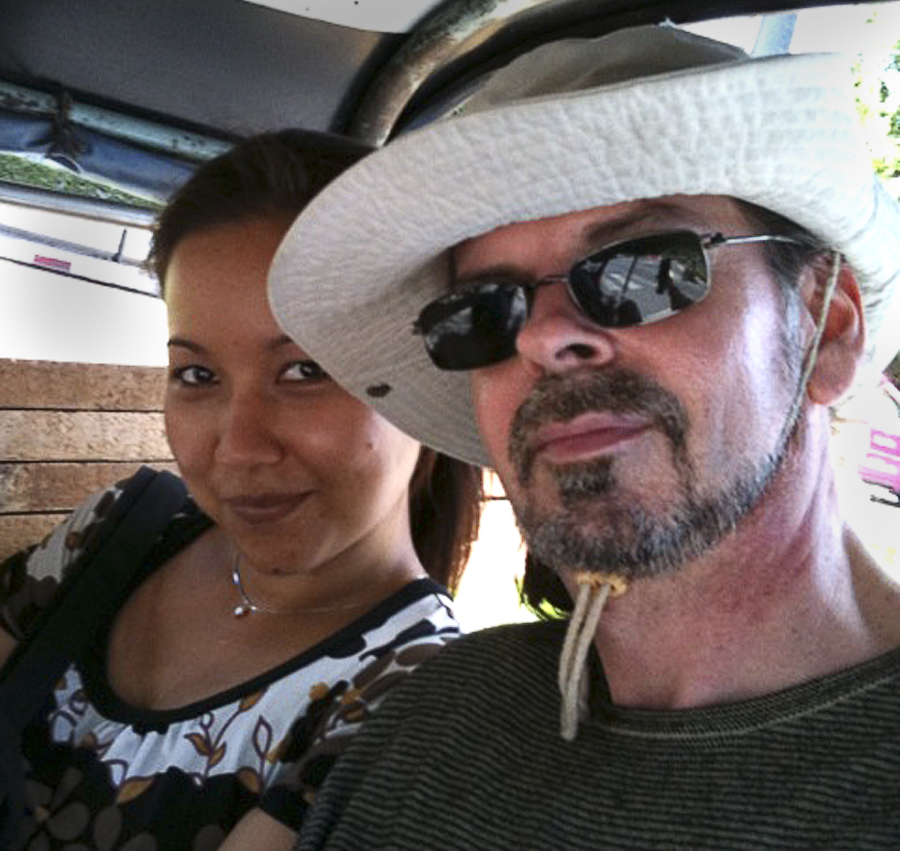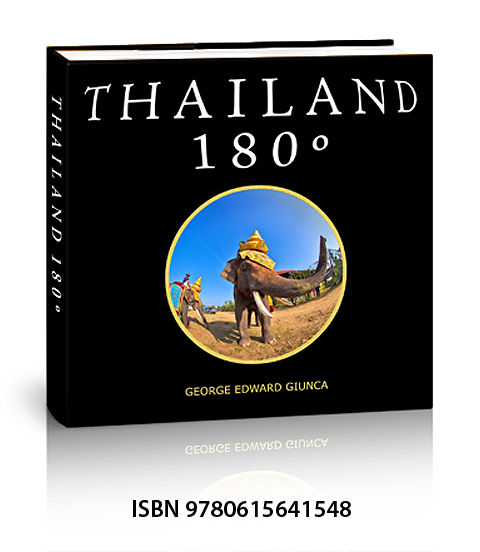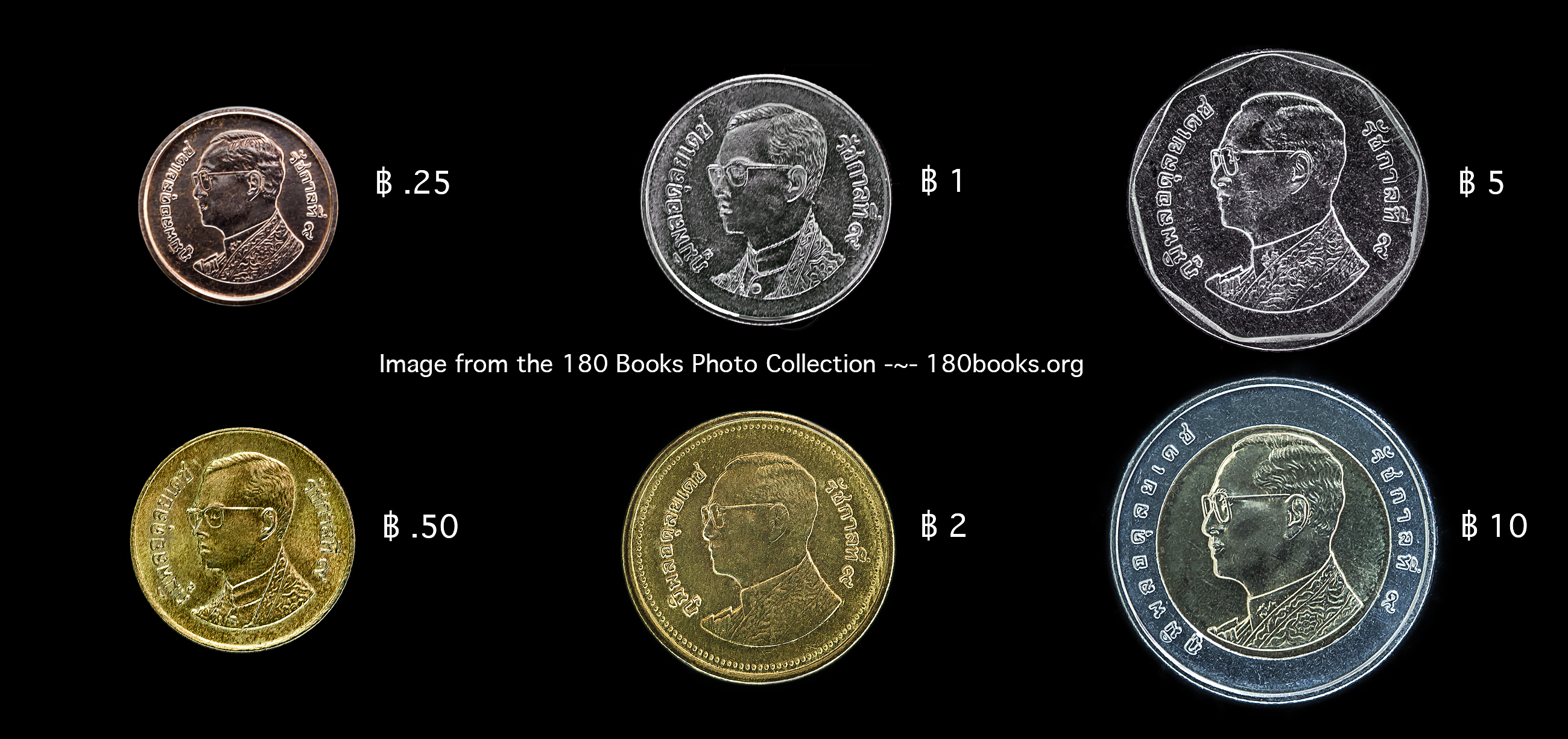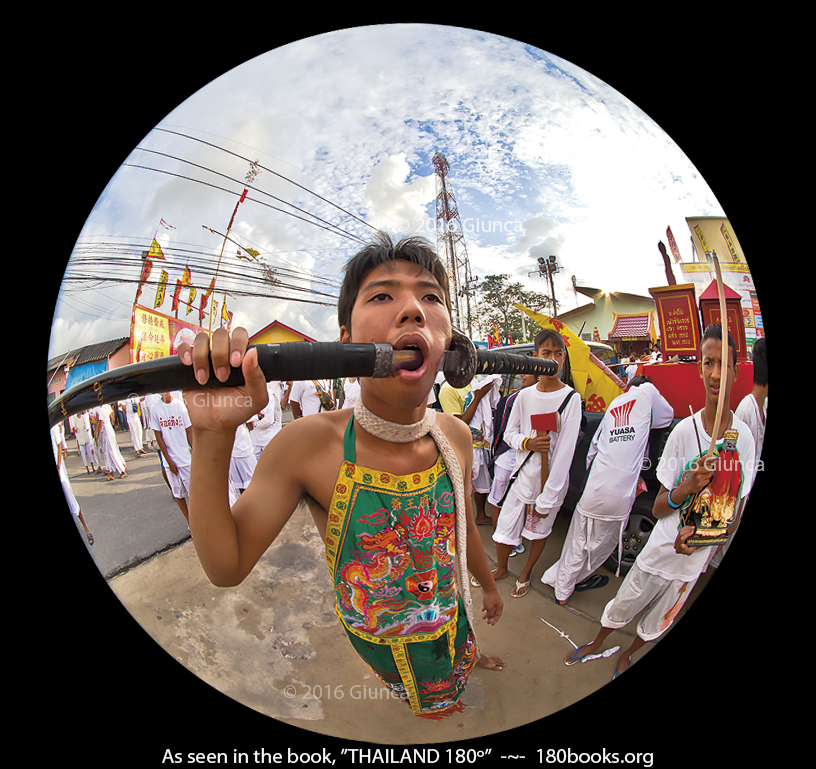180books & DALLE-2: End of the Honeymoon!
It’s probably best if you start by reading the first blog in this series that I wrote last week. Oh, last week was glorious! DALLE-2 and I had just recently met and I had decided to take our relationship to the next level. This week I discovered the dark side of DALLE-2. I’ve already punished it, as you’ll read in this article. I’m happy to say that we’ve put this matter behind us, we’re still working together, and making more Art than War, so all is well. Kinda.
Gypsies Traveling Through Srinagar, India
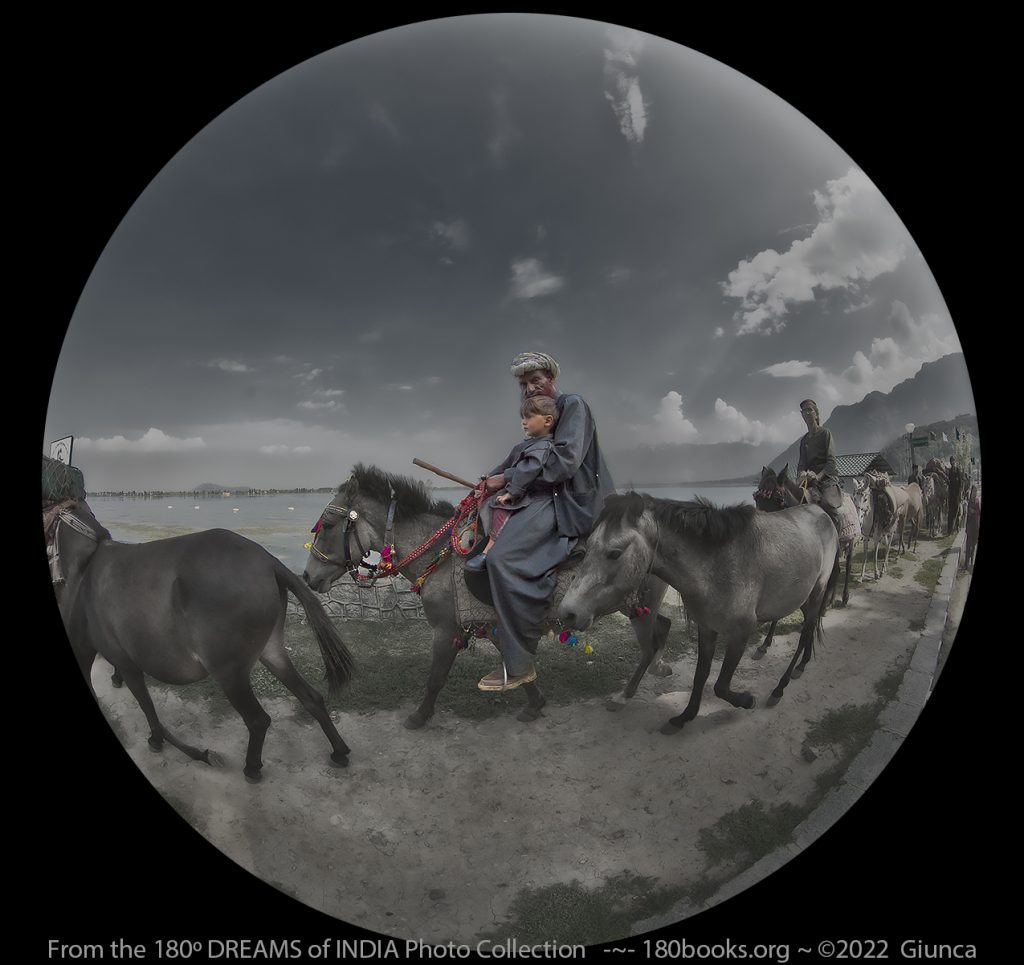
We were up early one morning to take pictures around Dal Lake in Srinagar, India, and while we were standing by the water, a band of gypsies rode by. I raised my camera a few times to ask permission to photograph them but they waved their hands NO! emphatically and kept riding. Because of my fisheye lens, I had to be very close to them so there was direct communication between us. I kept asking and they kept saying no, but I stood there because I HAD to have this picture. I abhor that style of street photography where photographers hide and secretly capture the poor and downtrodden in the harshest light possible, so sneaking a shot was not an option. I’m still a glamour photographer at heart.
Finally, towards the end of the procession, there was a man and a child and they were looking curiously at me. The old man was smiling and when I raised my camera and asked him if I could take a picture, he nodded enthusiastically. They struck a pose but kept on moving. This is one of my favorite photos from our “180º Dreams of India” collection. In this collection, I separated the subject from the background and other elements, placing them on different layers in Photoshop. I treated each of these layers differently as far as processing until I had a painterly dreamlike effect. This is the farthest I’ve ever gone in manipulating photos
DALLE-2 Goes for Baroque
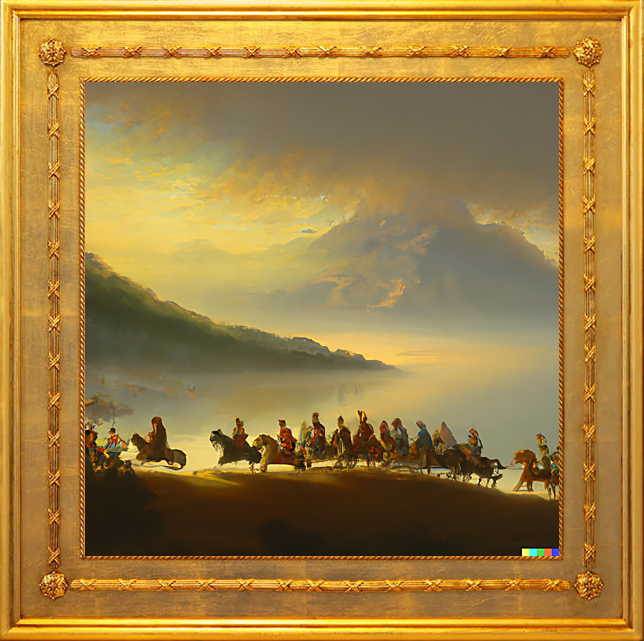
Once again I wanted a biblical-style painting and I thought of Giovanni Battista Lenardi. Lenardi was a baroque painter mainly working in Italy during the 17th Century. He probably didn’t visit India very often, but I loved the way he used light to stir emotions and the way he captured landscapes in the background, which seemed to go on forever. OpenAi API gave a reasonable description of his style, but I didn’t use it. Nor did I use its description of gypsies. I only used his name, Baroque, and a description of the scene, including location information. I was pleased with the results! It totally surpassed the image I had in my mind but I must say it’s also pretty darn close to the image that I was looking for.
Giovanni Battista Lenardi was a Venetian painter who was known for his use of color and light. His subjects were often religious or mythological, and he often used bright, bold colors in his paintings.
OpenAI API
Gypsies are a nomadic people who have traditionally lived in Europe. They are often associated with a romanticized image of a carefree people living a simple, wanderlust lifestyle. However, in reality, Gypsies have often faced discrimination and poverty.
OpenAI API
Vegetables at a Thai Market
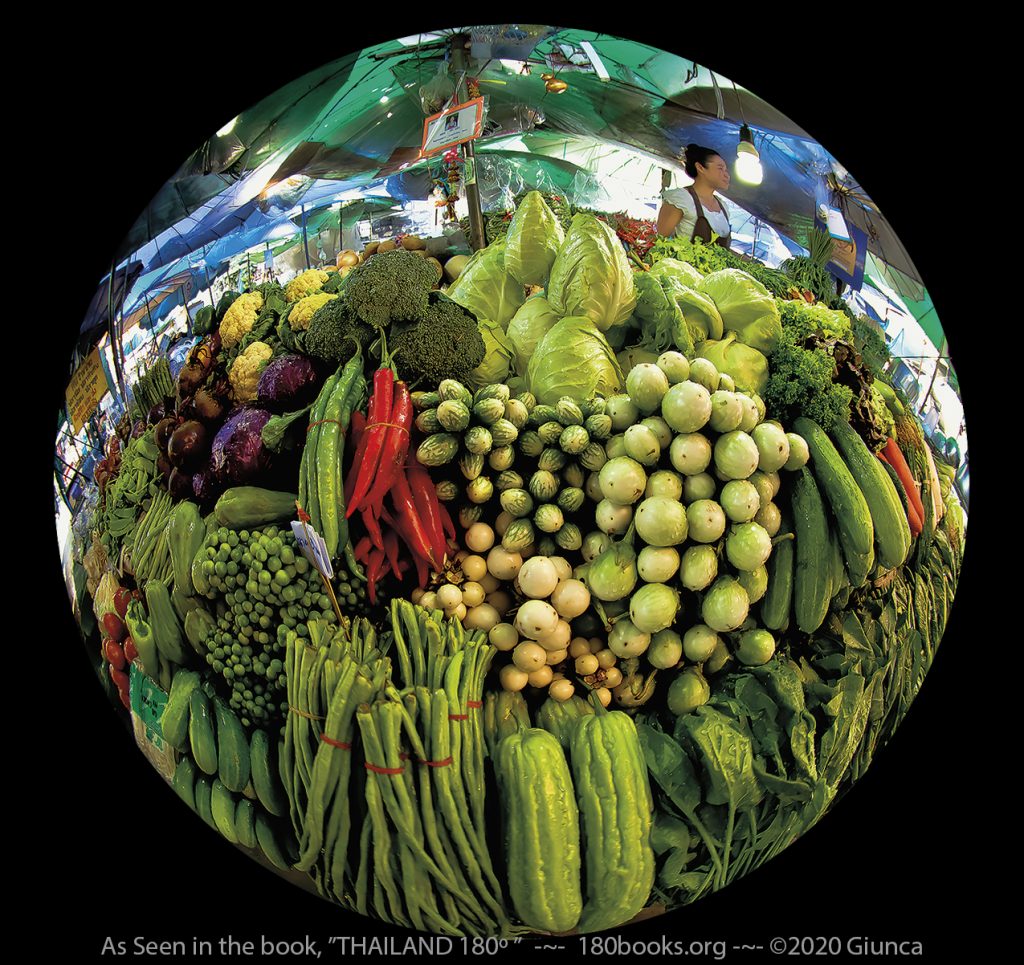
Thailand’s fresh markets are fascinating and I can’t resist their lure. One half of the market is usually dedicated to fresh ingredients like fruit, herbs, and vegetables that are beautifully arranged; the other half has food that’s being prepared. I go crazy taking photos in these markets and I guess 30% of my image catalog are images from markets. I have more than a touch of face pareidolia, so produce arrangements are of particular interest to me. With careful manual focus, the 8mm lens does a great job of preserving detail and gives a 3d dimensionality that I’ve grown fond of.
DALLE-2 Faces the Facts
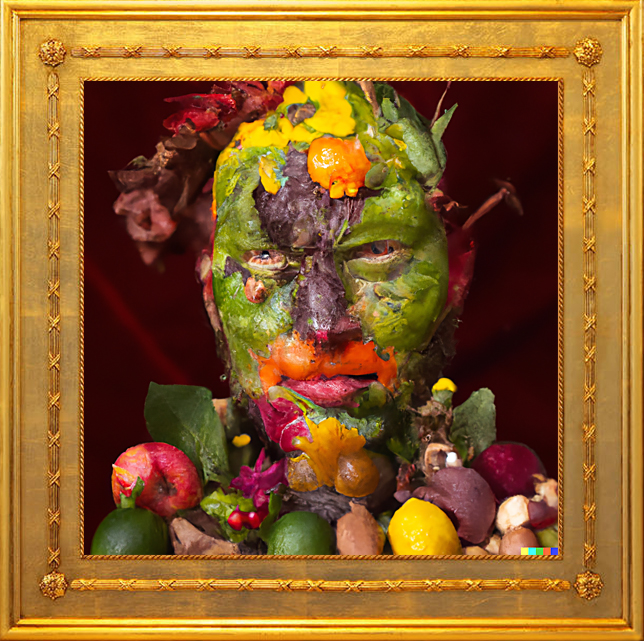
Yes! Whenever I see displays of vegetables, I think of Giuseppe Arcimboldo, known for his faces made of fruit and other items. Since the OpenAi API gave such a clear description of his style, I merely asked DALLE-2 to make a painting in his style, using Thai fruits and vegetables. I was pleased with the results and I’m thinking of recreating a similar sculpture for a Halloween salad. –Dare me in the comments and I just might try.
Giuseppe Arcimboldo was a 16th-century Italian painter known for his unique style of painting human faces and bodies made up of objects such as fruits, vegetables, flowers, fish, and books. His work is often seen as a humorous comment on the society of his time
OpenAI API
…And He Saw DINOSAURS!
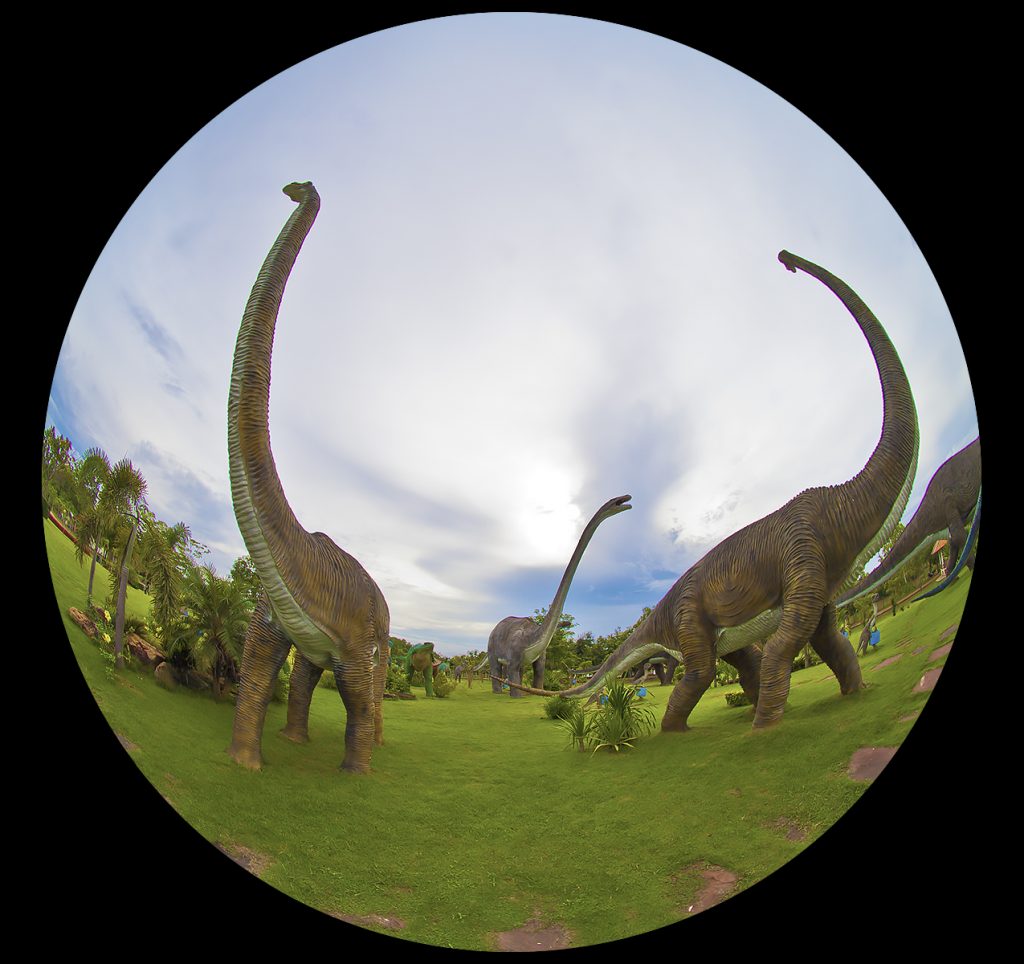
Danny and the Dinosaur by Syd Hoff was one of the first books I could read by myself as a child and it filled me with a lifelong love of dinosaurs and museums. (Yes, I know, impressive literary citation!) Kalasin, Thailand has both and is a peaceful place to visit in the northeastern part of the kingdom. When we arrived at the dinosaur park, I was horrified to find that the best angle was heavily backlit. Worse yet, a storm was approaching. I banged off a few shots just before a monsoon rain began to fall.
We waited as long as we could for the weather to change but eventually had to move on so we wouldn’t miss the Candle Festival. Travel photography is full of compromises like this. While I’m looking forward to enhancing my images with some of the technology that has surfaced in the last few years, I still have some qualms about how far I should alter my photography work. Almost all of my images are full-frame and were carefully cropped and exposed at the time I pressed the button. I don’t like fusion cuisine, and I like the idea that photographs are records of reality frozen in time. On the other hand, if I can make an image more visually appealing or expressive, shouldn’t I do it?
DALLE-2 Does Marc Chagall
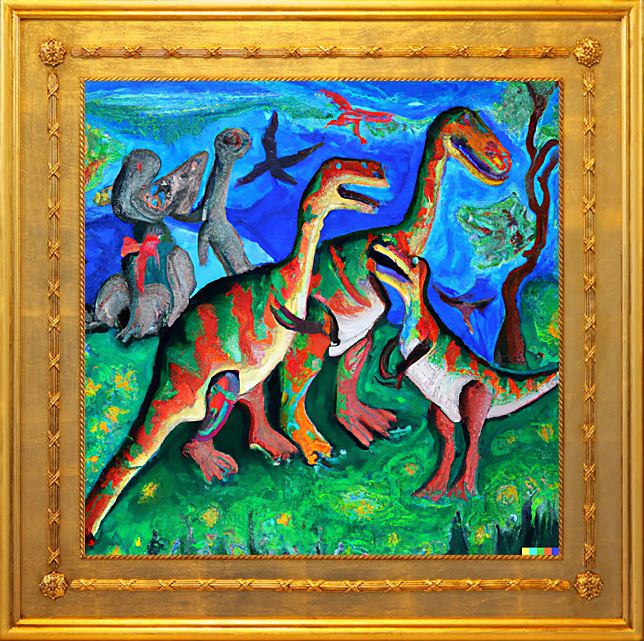
I wanted a painting that was fun and colorful, so I chose the artist Marc Chagall. After researching images created by DALLE-2, I noted that its forte was colorful and cute subjects. The lifesize dino statues at the park were scary critters so I tried to avoid anything too cute. Also, I didn’t want to name a specific type of dinosaur and confine the system’s creativity. DALLE-2 impressed me with its very first set of images. The bird-like creatures in the sky and the zoomorphic grey objects in the background were welcomed additions that I hadn’t mentioned. DALLE-2 wins this round.
Some style characteristics of a Marc Chagall painting are that they are usually very colorful, and often have a dreamlike quality to them. They often feature elements from both the real world and the world of imagination, and can be both whimsical and serious at the same time. Chagall’s paintings often have a strong emotional quality to them, and tell stories or convey messages through the use of symbols.
OpenAI API
The Elephant Banquet
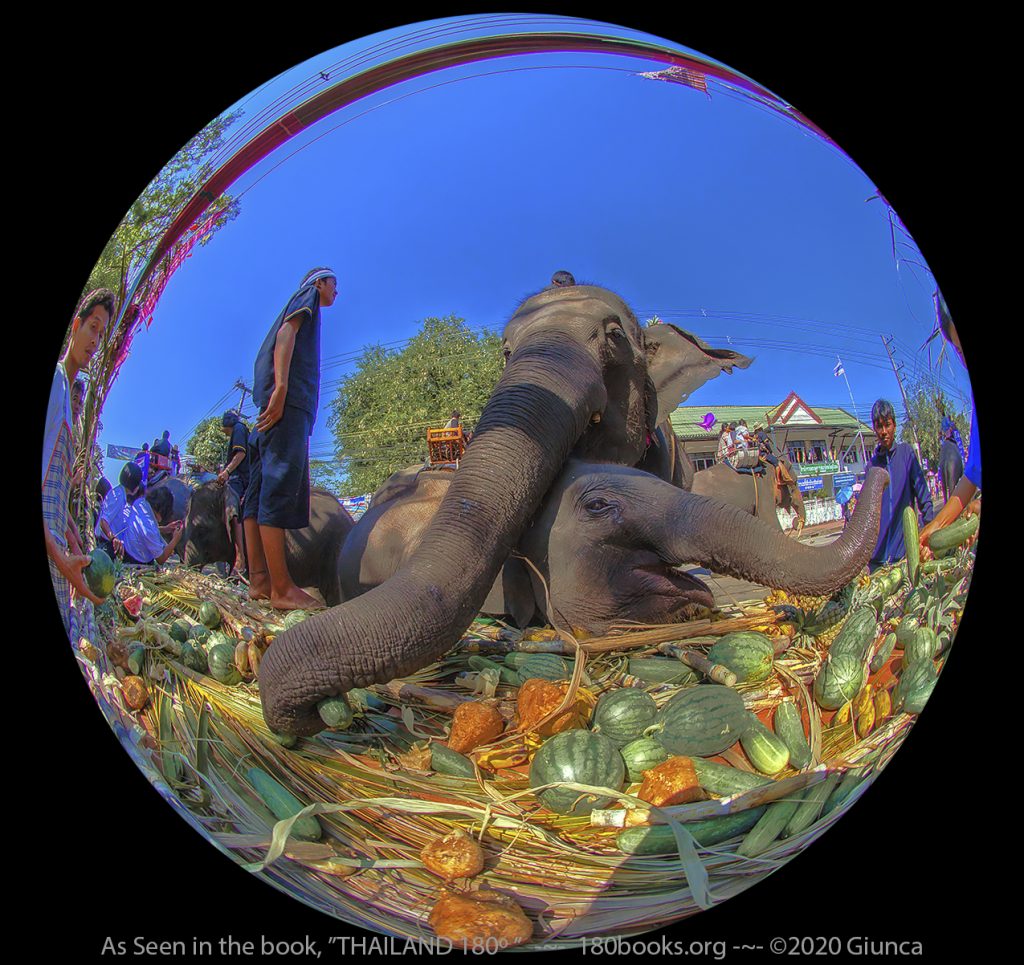
The Amazing Surin Elephant Round-up was one of the most difficult events that I’ve ever photographed, and we had no idea that we would capture an image for our book cover during this city photo safari. The mahouts and people of Surin have a great sense of pride as their hometown has earned the moniker, “Elephant City” and they put on an impressive show. There were hundreds of visiting pachyderms that were guided down the main street to endless tables full of fruit.
I had broken my ankle a few weeks earlier and was in a wheelchair, which gave me a lower perspective than I was used to. Elephants, although loveable, are voracious eaters with atrocious table manners. Their trunks almost smacked my lens several times, but I was pleased with several shots that I took throughout the afternoon.
Noooooo! DALLE-2!
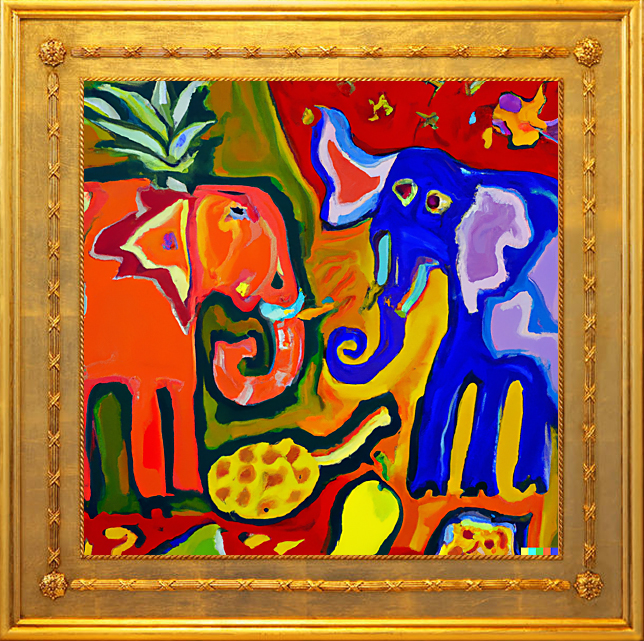
I wanted a dynamic painting, so I chose Joan Miro. At first, I liked the painting it provided, but then I realized that it was far from the painting I had in my mind. REAL Far! Looking at the Open API description of Miro, I understood why DALLE-2 had created the image it did. It completely ignored the name of the painting, “The Harlequin’s Carnival” I had also entered. I tried an edited version of the Open API description of the painting to no avail.
Miro’s style is characterized by its use of bright colors and simple shapes. His subjects often include everyday objects, such as clocks and chairs, which he transforms into whimsical, dreamlike images.
OpenAI API
“The Harlequin’s Carnival” is a painting by Joan Miro. It is a large painting, measuring approximately six feet by nine feet. The painting is composed of a series of interlocking shapes in a variety of colors. The shapes are arranged in a way that suggests movement and energy. The overall effect is that of a lively, chaotic scene.
OpenAI API
I Meant THIS Miro Painting!
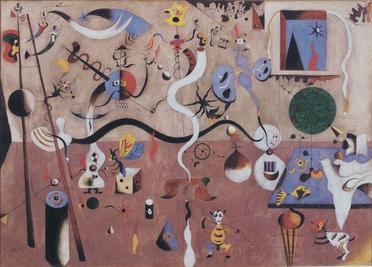
All through my tender high school years, a print of Miro’s painting, “The Harlequin’s Carnival” remained tastefully thumbtacked to my bedroom wall, just below a Jaclyn Smith poster. The subject of the painting is a Mardi Gras celebration and I couldn’t stop staring at it. In my mind, I saw a similar painting with abstract renderings of twisted elephants eating fruit from a table, and I also wondered what the heck happened to that JS poster.
I hear you say, “The poor craftsman blames his tools.” I too, figured that it was a failing on my part to write the correct incantation. After spending hours, upon hours researching and experimenting, I reached two conclusions. Either some art can’t be expressed with words (Duh!) or 400 characters is not enough allowance for complicated masterpieces.
Either way, I chose to blame DALLE-2!
DALLE-2, GO PUNISH YOURSELF!
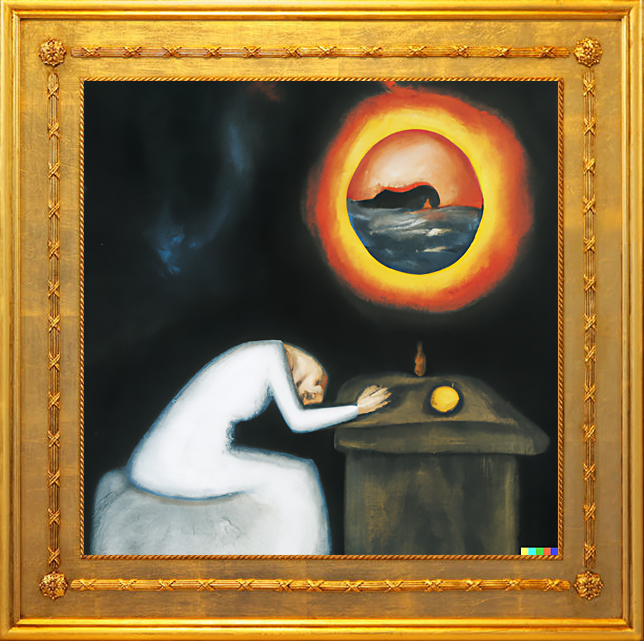
I had no idea how to punish an AI system so I allowed It to choose its own method. I wasn’t sure how It would react either. GO PUNISH YOURSELF! I commanded DALLE-2, and I mean in the style of El Greco, I added!! Ouch, It took that hard. The painting It created made me feel bad that I had lost my temper. Dressed all in white, a fisheye image of an elephant was still burning a hole in Its contrite mind. It appeared to be banging its head on the edge of the table and praying. Worse yet, It was drinking a beer with lemon.
Please DALLE-2, don’t abuse yourself or beer this way!
The Romeo and Juliet Effect
One thing I’ve noticed since working with Artificial Intelligence to create art is that the more times the system seems to resist producing the desired image, the more I want That image. This quest leads me to think more about the characteristics of the painting I want and creates a clearer picture in my mind, which in turn makes me love my visualized painting even more. Unless I capture these images on canvas, paper, or pixels, I fear some will haunt me, so I’m rooting for AI, but I’m dusting off my art supplies to hedge my bets.
I was still feeling sorry for DALLE-2 and didn’t want us to go to bed angry.
I decided to give It another shot.
The Chand Baori Stepwell
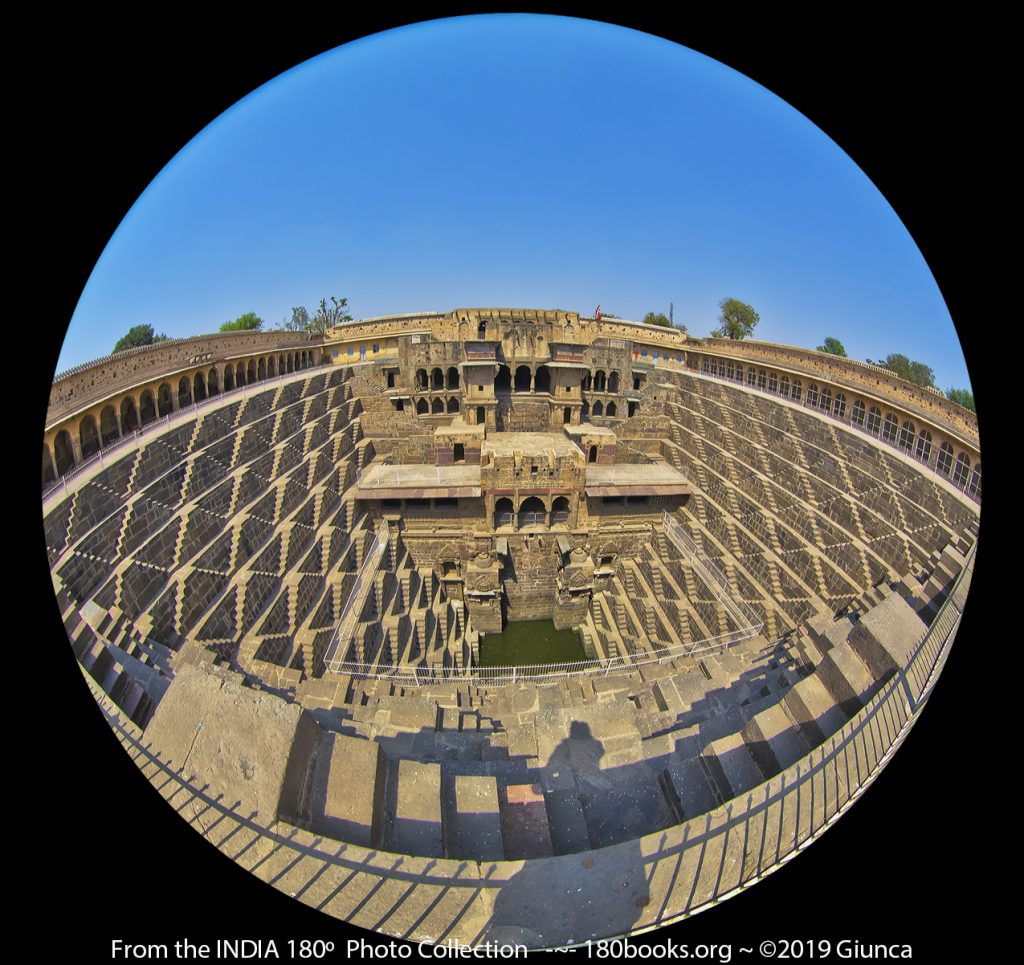
Chand Baori is a stepwell located in the village of Abhaneri in the Indian state of Rajasthan. The 8th & 9th-century masterpiece uses 3,500 steps to reach the bottom. Don’t be silly, of course I didn’t climb all the way down to the water level to take a shot looking up! It was closed. Yeah, that’s it. It was closed I tells ya! Although I wanted to be there earlier in the morning, the lighting was still good for showing depth and detail. Even as I looked around to take in its mind-bending massiveness, I couldn’t help but think of the artist M.C. Escher.
Up the Down Staircase with M.C. Escher
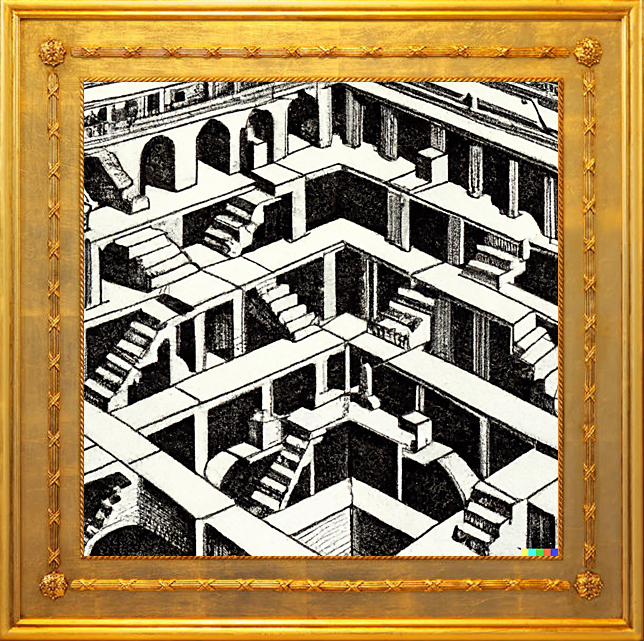
I recalled my original thoughts and gently asked DALLE-2 to make an image in the style of M. C. Escher. I used the API description and the name of the stepwell. The first set of images were good likenesses of the site, but had too much detail and lacked the optical effect of much of Escher’s work. I chose the simplest image and after clicking the Generate Variations button, I was given the image above. Although engineers might object to the differences in design, overall I’m pleased. I got greedy and tried to add some figures of people walking, but my AI friend didn’t want to help me with that.
M. C. Escher’s style is characterized by its use of impossible constructions, optical illusions, and tessellations.
OpenAI API
And so ends this collaboration of man and machine until next time...
NFTs? Yeah, We Do That!

About the Authors
Photographer George Edward Giunca and his Thai wife have traveled around Thailand armed with a circular fisheye lens to create a photo essay on the rich cultural diversity, and abundant natural beauty of the Kingdom of Thailand. Fleeing from angry water buffaloes, slapping huge mosquitoes, watching exotic festivals and religious rituals, gorging on delicious spicy food, applying aloe vera cream to sunburned skin, wading through rice paddies, getting drenched to the bone by heavy monsoon rains, and gawking at breath-taking scenery; made it a journey of epic proportions! The result is the book, THAILAND 180º. Later, they traveled extensively through Myanmar, Malaysia, and India, gathering a massive collection of 180º photos. They currently live in Bangkok, Thailand.
Here’s How to Order Your Copy of THAILAND 180º Collectors Edition Today!
In Thailand —>>>http://www.thailand180.com/thaiorder.html
The Rest of the world: We are offering our book on Amazon.com, below list price http://amzn.to/1knDPRR
Not Familiar with Our Book???
This show details the origin of 180 Books, a series of art/travel books illustrated with a circular fisheye lens. By using infographics, pictures from our THAILAND 180º book, and never seen before images from our vault, we’ll demonstrate this unique lens and present our unique books.


